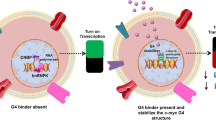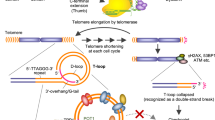Abstract
The RET (rearranged during transfection) proto-oncogene encodes a receptor tyrosine kinase for members of the glial cell line-derived neurotrophic factor family of extracellular signaling molecules. The activating germline point mutations in the RET, which are known to induce oncogenic activation of RET tyrosine kinase, are associated with the development of medullary thyroid carcinoma (MTC) and pathogenesis of multiple endocrine neoplasia type 2 (MEN2). The polypurine/polypyrimidine tract in the proximal promoter region of the human RET gene (−51 to −33 relative to transcription start site) is essential for basal transcriptional activity of this gene. This tract consists of a guanine-rich sequence containing five runs of at least three contiguous guanines separated by one or more bases, conforming to a general motif capable of forming an intramolecular G-quadruplex. Here, we show that specific G-quadruplex structures formed in the RET promoter region act to repress the transcription of this gene, and transcription of this gene can be controlled by ligand-mediated G-quadruplex stabilization. In this study, NSC194598, a derivative of indeno[1,2,3-de]quinazoline, was found to be a novel G-quadruplex interactive agent that interfered with transcriptional activation of mutated RET gene in human medullary thyroid carcinoma TT cells. This compound significantly reduced endogenous RET protein levels and increased apoptosis in these cells. Our results provide further support for the idea that G-quadruplex structures may have a critical role in transcriptional regulation of the RET gene in vivo, providing insight into a novel strategy for transcriptional repression of this gene by small molecules.
This is a preview of subscription content, access via your institution
Access options
Subscribe to this journal
Receive 50 print issues and online access
$259.00 per year
only $5.18 per issue
Buy this article
- Purchase on Springer Link
- Instant access to full article PDF
Prices may be subject to local taxes which are calculated during checkout






Similar content being viewed by others
References
Massoll N, Mazzaferri EL . Diagnosis and management of medullary thyroid carcinoma. Clin Lab Med 2004; 24: 49–83.
Niccoli-Sire P, Conte-Devolx B . Multiple endocrine neoplasia type 2. Ann Endocrinol (Paris) 2007; 68: 317–324.
Lodish MB, Stratakis CA . RET oncogene in MEN2, MEN2B, MTC and other forms of thyroid cancer. Expert Rev Anticancer Ther 2008; 8: 625–632.
Carter MT, Yome JL, Marcil MN, Martin CA, Vanhorne JB, Mulligan LM . Conservation of RET proto-oncogene splicing variants and implications for RET isoform function. Cytogenet Cell Genet 2001; 95: 169–176.
Runeberg-Roos P, Saarma M . Neurotrophic factor receptor RET: structure, cell biology, and inherited diseases. Ann Med 2007; 39: 572–580.
de Groot JW, Links TP, Plukker JT, Lips CJ, Hofstra RM . RET as a diagnostic and therapeutic target in sporadic and hereditary endocrine tumors. Endocr Rev 2006; 27: 535–560.
Plaza-Menacho I, Burzynski GM, de Groot JW, Eggen BJ, Hofstra RM . Current concepts in RET-related genetics, signaling and therapeutics. Trends Genet 2006; 22: 627–636.
Wells Jr. SA, Santoro M . Targeting the RET pathway in thyroid cancer. Clin Cancer Res 2009; 15: 7119–7123.
Andrew SD, Delhanty PJ, Mulligan LM, Robinson BG . Sp1 and Sp3 transactivate the RET proto-oncogene promoter. Gene 2000; 256: 283–291.
Andrew SD, Capes-Davis A, Delhanty PJ, Marsh DJ, Mulligan LM, Robinson BG . Transcriptional repression of the RET proto-oncogene by a mitogen activated protein kinase-dependent signalling pathway. Gene 2002; 298: 9–19.
Bachetti T, Borghini S, Ravazzolo R, Ceccherini I . An in vitro approach to test the possible role of candidate factors in the transcriptional regulation of the RET proto-oncogene. Gene Expr 2005; 12: 137–149.
Todd AK, Neidle S . The relationship of potential G-quadruplex sequences in cis-upstream regions of the human genome to SP1-binding elements. Nucleic Acids Res 2008; 36: 2700–2704.
Evans T, Efstratiadis A . Sequence-dependent S1 nuclease hypersensitivity of a heteronomous DNA duplex. J Biol Chem 1986; 261: 14771–14780.
McCarthy JG, Heywood SM . A long polypyrimidine/polypurine tract induces an altered DNA conformation on the 3′ coding region of the adjacent myosin heavy chain gene. Nucleic Acids Res 1987; 15: 8069–8085.
Rustighi A, Tessari MA, Vascotto F, Sgarra R, Giancotti V, Manfioletti G . A polypyrimidine/polypurine tract within the Hmga2 minimal promoter: a common feature of many growth-related genes. Biochemistry 2002; 41: 1229–1240.
Sun D, Guo K, Rusche JJ, Hurley LH . Facilitation of a structural transition in the polypurine/polypyrimidine tract within the proximal promoter region of the human VEGF gene by the presence of potassium and G-quadruplex-interactive agents. Nucleic Acids Res 2005; 33: 6070–6080.
Simonsson T . G-quadruplex DNA structures—variations on a theme. Biol Chem 2001; 382: 621–628.
Parkinson GN, Lee MP, Neidle S . Crystal structure of parallel quadruplexes from human telomeric DNA. Nature 2002; 417: 876–880.
Phan AT, Modi YS, Patel DJ . Propeller-type parallel-stranded G-quadruplexes in the human c-myc promoter. J Am Chem Soc 2004; 126: 8710–8716.
Dai J, Dexheimer TS, Chen D, Carver M, Ambrus A, Jones RA et al. An intramolecular G-quadruplex structure with mixed parallel/antiparallel G-strands formed in the human BCL-2 promoter region in solution. J Am Chem Soc 2006; 128: 1096–1108.
Siddiqui-Jain A, Grand CL, Bearss DJ, Hurley LH . Direct evidence for a G-quadruplex in a promoter region and its targeting with a small molecule to repress c-MYC transcription. Proc Natl Acad Sci USA 2002; 99: 11593–11598.
Sun D, Guo K, Shin YJ . Evidence of the formation of G-quadruplex structures in the promoter region of the human vascular endothelial growth factor gene. Nucleic Acids Res 2011; 39: 1256–1265.
Biffi G, Tannahill D, McCafferty J, Balasubramanian S . Quantitative visualization of DNA G-quadruplex structures in human cells. Nat Chem 2013; 5: 182–186.
Lam EY, Beraldi D, Tannahill D, Balasubramanian S . G-quadruplex structures are stable and detectable in human genomic DNA. Nat Commun 2013; 4: 1796–1803.
Guo K, Pourpak A, Beetz-Rogers K, Gokhale V, Sun D, Hurley LH . Formation of pseudosymmetrical G-quadruplex and i-motif structures in the proximal promoter region of the RET oncogene. J Am Chem Soc 2007; 129: 10220–10228.
O'Gorman S, Fox DT, Wahl GM . Recombinase-mediated gene activation and site-specific integration in mammalian cells. Science 1991; 251: 1351–1355.
Yan C, Wang H, Aggarwal B, Boyd DD . A novel homologous recombination system to study 92 kDa type IV collagenase transcription demonstrates that the NF-kappaB motif drives the transition from a repressed to an activated state of gene expression. FASEB J 2004; 18: 540–541.
Nair RR, Avila H, Ma X, Wang Z, Lennartz M, Darnay BG et al. A novel high-throughput screening system identifies a small molecule repressive for matrix metalloproteinase-9 expression. Mol Pharmacol 2008; 73: 919–929.
Han H, Hurley LH, Salazar M . A DNA polymerase stop assay for G-quadruplex-interactive compounds. Nucleic Acids Res 1999; 27: 537–542.
Sassano MF, Schlesinger AP, Jarstfer MB . Identification of G-Quadruplex Inducers Usinga Simple, Inexpensiveand Rapid High Throughput Assay, and Their Inhibition of Human Telomerase. Open Med Chem J 2012; 6: 20–28.
Rahman KM, Tizkova K, Reszka AP, Neidle S, Thurston DE . Identification of novel telomeric G-quadruplex-targeting chemical scaffolds through screening of three NCI libraries. Bioorg Med Chem Lett 2012; 22: 3006–3010.
Gray DM, Gray CW, Mou TC, Wen JD . CD of single-stranded, double-stranded, and G-quartet nucleic acids in complexes with a single-stranded DNA-binding protein. Enantiomer 2002; 7: 49–58.
Belloc F, Dumain P, Boisseau MR, Jalloustre C, Reiffers J, Bernard P Lacombe F et alA flow cytometric method using Hoechst 33342 and propidium iodide for simultaneous cell cycle analysis and apoptosis determination in unfixed cells. Cytometry 1994; 17: 59–65.
Acknowledgements
We thank the American Cancer Society for support of this work (RSGM-12-046-01-CDD).
Author information
Authors and Affiliations
Corresponding author
Ethics declarations
Competing interests
The authors declare no conflict of interest.
Rights and permissions
About this article
Cite this article
Shin, YJ., Kumarasamy, V., Camacho, D. et al. Involvement of G-quadruplex structures in regulation of human RET gene expression by small molecules in human medullary thyroid carcinoma TT cells. Oncogene 34, 1292–1299 (2015). https://doi.org/10.1038/onc.2014.65
Received:
Revised:
Accepted:
Published:
Issue Date:
DOI: https://doi.org/10.1038/onc.2014.65



